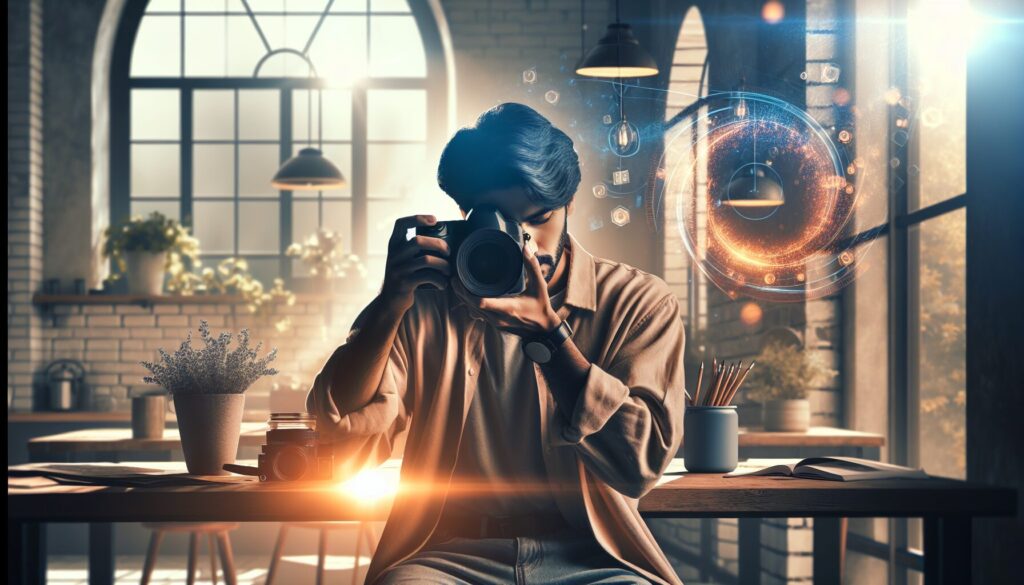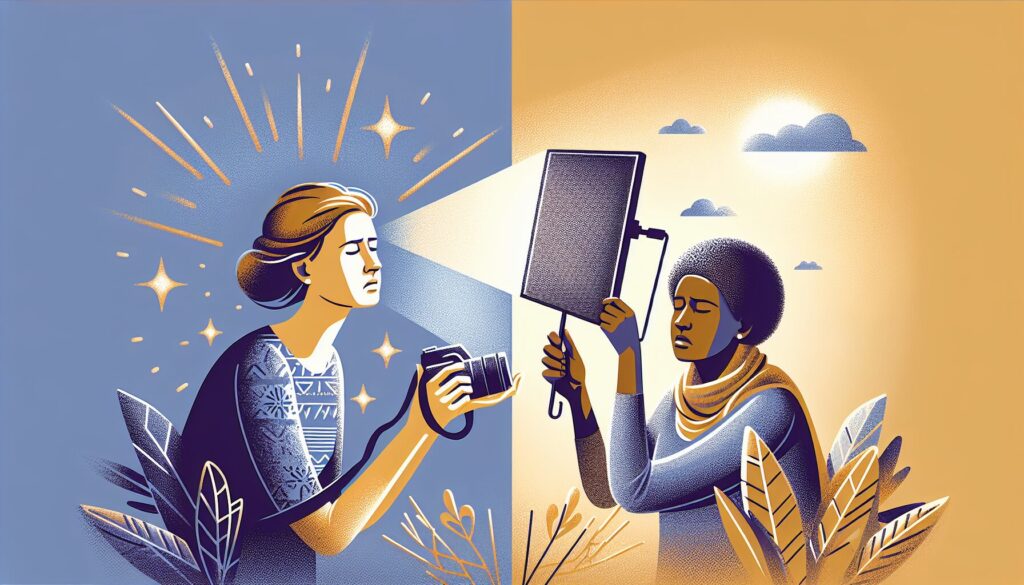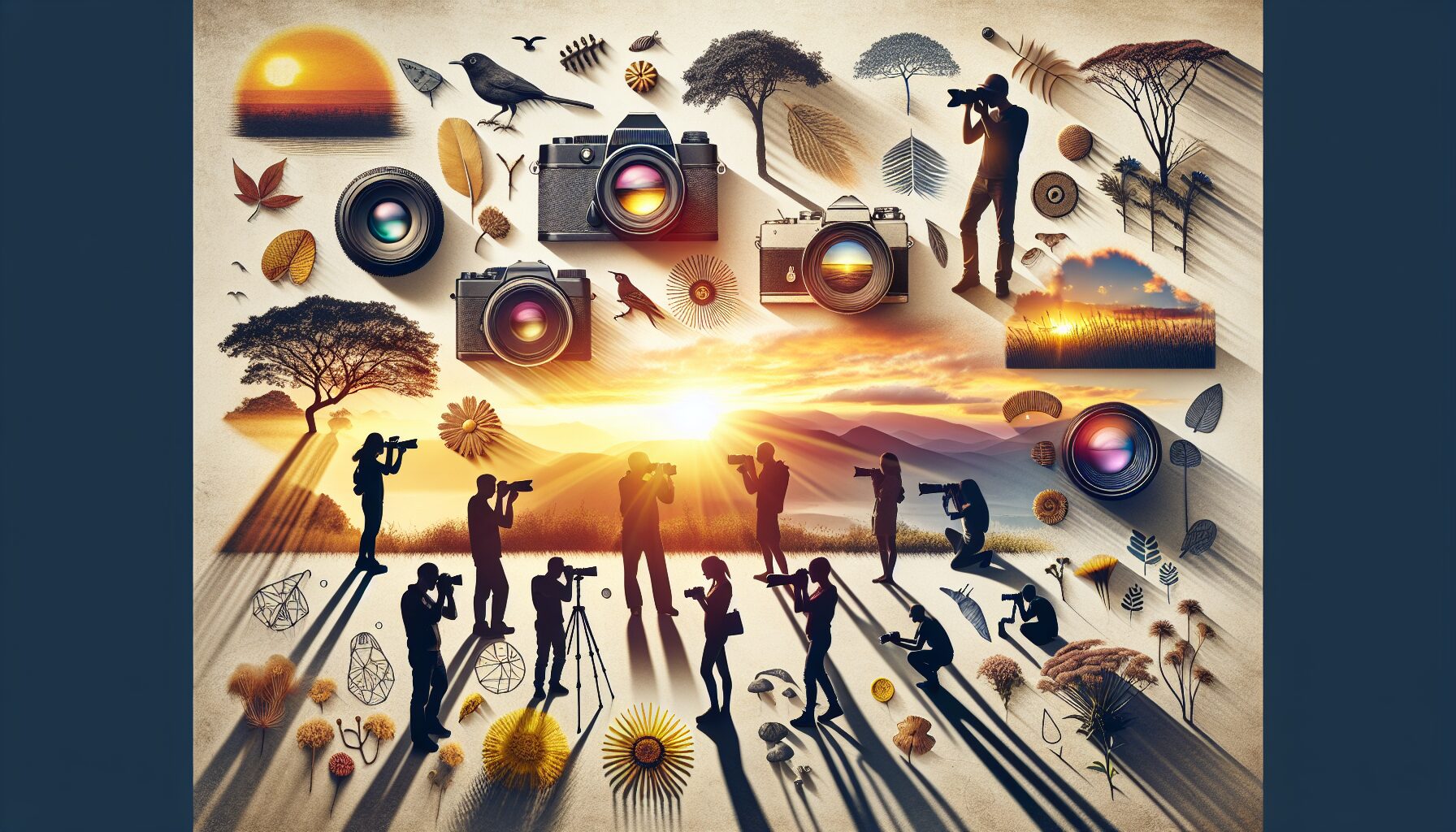Imagine capturing the vibrant colors of a bustling Karachi street market with nothing but the natural glow of the sun. That’s the magic of natural light photography! Years ago, I found myself in Lahore with my trusty Canon EOS R5 and a 50mm f/1.8 lens, keen to capture the essence of the city. The way the sunlight danced across the historic Badshahi Mosque was mesmerizing. With settings like ISO 100 and f/16, I captured images full of authenticity and warmth. Natural light can bring out the true colors and textures in any scene, offering an honest representation of the moment. Techniques like using a polarizing filter can help manage reflections and enhance colors, making the photos even more striking. Whether you’re photographing the lush landscapes of Swat Valley or a quiet village in Punjab, embracing natural light can truly transform your photography journey.
Related: Natural Light Photography: A Deep Dive Into Techniques
Benefits of Using Natural Light in Photography
Natural light in photography can truly transform a picture, adding depth and realism. I remember one sunny afternoon in Lahore, I was out with my trusty Canon EOS R5 and a 50mm f/1.8 lens. The natural light was perfect, and I set my camera to ISO 100, f/16, and 1/30s to capture the vibrant colors of the bustling streets. The images turned out stunningly authentic, with rich details and vibrant hues, all thanks to the natural light.
One of the key benefits of using natural light is its ability to create authentic and true-to-life images. Artificial lights can sometimes distort colors, but natural light preserves them. When I shoot portraits, like in the beautiful Shalimar Gardens, I prefer using early morning light. It casts a soft glow, accentuating natural skin tones and textures. This approach ensures that the essence of the subject is captured without harsh shadows or unnatural highlights.
Enhancing Mood and Atmosphere
Additionally, natural light has a unique way of enhancing the mood and atmosphere of a scene. Whether it’s the golden light of a Karachi sunset or the soft light filtering through the clouds in Islamabad, it adds an emotional layer to photographs. This quality is something artificial lights often struggle to replicate. Moreover, shooting in natural light is cost-effective and accessible. You don’t need to invest in expensive lighting equipment. All you need is a keen eye for the perfect moment when the light is just right.
Furthermore, natural light encourages spontaneity. You’re not restricted by studio setups and can explore creative compositions. During a trip to the Hunza Valley, I used a polarizing filter to manage reflections and enhance the vibrancy of the landscape. The result was breathtakingly genuine, capturing the majestic beauty of the region. Organizations like `National Geographic` often emphasize the importance of natural light for capturing authentic, evocative imagery. Whether you’re a seasoned photographer or just starting out, embracing natural light can elevate your work to new heights.
How Natural Light Enhances Authenticity

Have you ever noticed how photographs taken in natural light seem more genuine? There’s something about the soft glow of the sun that brings out the realness in a scene. I remember a trip to the stunning Hunza Valley where I was armed with my trusty Canon EOS R5 and a 50mm f/1.8 lens. The way the morning light danced on the Karakoram Mountains left me speechless and eager to capture that breathtaking moment. I set my camera to ISO 100, with an aperture of f/16 and a shutter speed of 1/30s. These settings made the colors pop and the shadows just right, enhancing the authenticity of the scene.
Natural light, especially during the golden hours, offers a softer contrast and more vivid colors. This is something artificial lights often struggle to replicate. Additionally, when you shoot in natural light, you’re allowing the true colors of the environment to shine through. This is crucial for authenticity in photography. For instance, the vibrant hues of a bustling Pakistani bazaar come alive under the sun’s rays, as opposed to harsh artificial lighting.
The Role of Natural Light in Storytelling
Natural light doesn’t just enhance visuals; it also tells a story. When I shot a wedding in Lahore, the natural light filtered through the grand windows of the venue. It created an ethereal atmosphere that no studio light could mimic. The couple’s joy was beautifully captured, and the emotions felt genuine and unposed. Moreover, natural light photography connects the subject to their environment, grounding the image in reality. This connection is vital for conveying a true narrative.
According to National Geographic, photos taken in natural light can evoke stronger emotional responses. This is because they resonate with viewers on a more personal level. So, next time you’re out with your camera, embrace the sun’s glow and let it enhance the authenticity of your captures.
Techniques for Capturing the Best Natural Light
Capturing the beauty of natural light in Pakistan is an art that can transform your photos into authentic masterpieces. One of my favorite techniques involves using the golden hours—the magical times just after sunrise and before sunset. During a trip to the stunning landscapes of Hunza Valley, I used my Canon EOS R5 paired with a 50mm f/1.8 lens. The results were breathtaking, with soft, warm light that highlighted the valley’s natural beauty. I set my camera to ISO 100, f/4, and a shutter speed of 1/125s to perfectly balance the light and capture vibrant colors.
Additionally, understanding the direction and quality of light is crucial. When photographing in Lahore’s bustling streets, I often position myself with the sun behind me. This technique illuminates subjects evenly and reduces harsh shadows. A polarizing filter can also work wonders by enhancing colors and reducing reflections, especially in bright midday sun.
Using Shadows and Reflections
Another trick is to play with shadows and reflections. In Karachi, with its beautiful beaches, I love capturing reflections during low tides. Reflections can add depth and interest to your photos, making them more authentic and engaging. To get these stunning shots, I use a wide-angle lens like the 24-70mm f/2.8. This lens gives a broader perspective and captures more of the scene. For settings, I often choose f/11 to ensure a deep depth of field, keeping everything sharp.
When shooting indoors, such as in the ancient architecture of Mohenjo-Daro, using natural window light is key. Position your subject near a window for soft, diffused light. This technique adds warmth and authenticity to portraits. For anyone eager to explore different photography styles in Pakistan, check out our comprehensive guide to photography genres. It’s a must-read for enthusiasts looking to explore new techniques.
Finally, don’t forget to experiment and adapt. Every location in Pakistan offers unique lighting challenges and opportunities. By practicing these techniques and adjusting your settings, you’ll capture the true essence of each moment, creating photos that speak volumes.
Challenges and Solutions in Natural Light Photography

Capturing the essence of a scene with natural light can be both rewarding and challenging. I remember one chilly morning in Lahore, armed with my trusty Canon EOS R5 and a 50mm f/1.8 lens, I set out to photograph the bustling streets. The ambient light was stunning, but the ever-changing conditions were a test of patience and skill. The sun kept playing hide and seek behind the clouds, which meant frequent adjustments to my camera settings. I had to quickly switch between ISO 100 and ISO 400 to maintain the right exposure, while keeping my aperture at f/2.8 for a soft background.
One significant challenge in natural light photography is dealing with harsh midday sunlight. It often creates unwanted shadows and highlights. A great solution is to use a polarizing filter. It helps reduce glare and enhances colors, making your photos pop without losing authenticity. Additionally, shooting during the golden hour—just after sunrise or before sunset—provides softer, more flattering light. This time of day casts a warm glow, adding an authentic touch to portraits and landscapes.
Embracing Variable Weather Conditions
Weather can be unpredictable in Pakistan, and this unpredictability can affect your shots. Overcast days, however, offer diffused light that’s perfect for portraits. On such days, I often set my camera to ISO 200 with an aperture of f/4.0 to get crisp images with natural skin tones. When the sun finally breaks through, it can create dramatic rays and shadows. It’s these challenges that keep natural light photography exciting and genuine.
For those new to this type of photography, practice and patience are key. Join local photography groups like Lahore Photography Club to connect with fellow enthusiasts. Engaging with these communities can provide valuable tips and inspiration to navigate the challenges of capturing authenticity through natural light.
Case Studies: Authenticity in Natural Light Photography
Let me take you on a little journey through the vibrant streets of Lahore, where I once captured a moment that felt truly authentic. I was using my trusty Canon EOS R5 with a 50mm f/1.8 lens. The sun was setting, casting a golden glow over the bustling Anarkali Bazaar. I set my camera to ISO 100, f/16, and 1/30s to catch the perfect balance of light and shadow. The scene was bustling with energy, and the natural light brought out the genuine expressions of vendors and shoppers alike.
Natural light has this magical ability to enhance the authenticity of a photograph. It avoids the harshness of artificial lighting and instead, highlights the true colors and textures of a scene. Take, for example, a wedding I shot in the serene valleys of Hunza. The bride and groom stood against the majestic mountains, and the soft, diffused light of the early morning sun painted a picture of serene beauty. With my Nikon D850, a 24-70mm f/2.8 lens, and settings at ISO 200, f/11, and 1/60s, I was able to capture their genuine joy in a way that studio lights simply couldn’t replicate.
Real-Life Examples of Natural Light Photography
In Karachi, I once collaborated with Karachi Photography Club for a street photography project. Capturing the vibrant life of the city in natural light revealed stories that artificial lighting would have overshadowed. The project involved using a Sony A7 III, fitted with a 35mm f/1.4 lens. Adjusting to ISO 400, f/5.6, and 1/125s, I could photograph everything from the intricate patterns of truck art to the lively expressions of local children playing in the streets. This approach to photography ensures that what you see is what you get, preserving the true essence of the moment.
Conclusion
Ultimately, natural light photography offers a wealth of benefits, capturing the authenticity and vibrant colors of a scene in ways that artificial lighting often cannot replicate. By harnessing the gentle illumination of the sun, photographers can create images that are rich in detail, mood, and atmosphere. Techniques like using polarizing filters and shooting during golden hours further enhance the quality of natural light images. Although challenges such as fluctuating weather and harsh midday sunlight exist, these can be addressed with practice and patience. Through real-life examples, from the bustling streets of Lahore to the serene valleys of Hunza, it’s clear that natural light is a powerful tool for storytelling and capturing genuine emotions. Embracing the spontaneity and accessibility of natural light can transform your photography journey into one of authenticity and creativity. Keep experimenting and let the natural light guide your lens. Happy shooting!
Continue Exploring
Unlock the secrets of stunning sunset shots with our expert tips. Dive into the world of golden hour photography and transform your captures into breathtaking masterpieces.
Frequently Asked Questions
What are the benefits of natural light photography for achieving authenticity in photos?
Natural light photography offers a unique authenticity to images by capturing subjects in their true colors and textures without the artificial influence of studio lighting. It highlights the natural beauty and mood of the scene, creating a more genuine and relatable image that resonates with viewers.
How does natural light photography contribute to the authenticity of portraits?
Natural light photography enhances the authenticity of portraits by using the soft, diffused light of the sun to create flattering, natural-looking skin tones and shadows. This approach avoids harsh lighting effects, allowing the true personality and emotions of the subject to shine through, resulting in more honest and engaging portraits.
Why is natural light important for capturing authentic moments in photography?
Natural light is crucial for capturing authentic moments because it reflects the environment as it truly is, preserving the atmosphere and emotions of the scene. It helps in documenting moments with minimal interference, allowing photographers to capture spontaneous and genuine expressions, which are often lost under artificial lighting conditions.


Leave a Reply